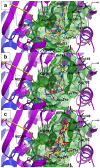A metal-based inhibitor of NEDD8-activating enzyme
- PMID: 23185368
- PMCID: PMC3501507
- DOI: 10.1371/journal.pone.0049574
A metal-based inhibitor of NEDD8-activating enzyme
Abstract
A cyclometallated rhodium(III) complex [Rh(ppy)(2)(dppz)](+) (1) (where ppy=2-phenylpyridine and dppz=dipyrido[3,2-a:2',3'-c]phenazine dipyridophenazine) has been prepared and identified as an inhibitor of NEDD8-activating enzyme (NAE). The complex inhibited NAE activity in cell-free and cell-based assays, and suppressed the CRL-regulated substrate degradation and NF-κB activation in human cancer cells with potency comparable to known NAE inhibitor MLN4924. Molecular modeling analysis suggested that the overall binding mode of 1 within the binding pocket of the APPBP1/UBA3 heterodimer resembled that for MLN4924. Complex 1 is the first metal complex reported to suppress the NEDDylation pathway via inhibition of the NEDD8-activating enzyme.
Conflict of interest statement
Figures





Similar articles
-
Mutations in UBA3 confer resistance to the NEDD8-activating enzyme inhibitor MLN4924 in human leukemic cells.PLoS One. 2014 Apr 1;9(4):e93530. doi: 10.1371/journal.pone.0093530. eCollection 2014. PLoS One. 2014. PMID: 24691136 Free PMC article.
-
Inhibitory effect of a neddylation blockade on HTLV-1-infected T cells via modulation of NF-κB, AP-1, and Akt signaling.Leuk Lymphoma. 2024 Jul;65(7):978-988. doi: 10.1080/10428194.2024.2328219. Epub 2024 Mar 15. Leuk Lymphoma. 2024. PMID: 38489672
-
MLN4924, a NEDD8-activating enzyme inhibitor, is active in diffuse large B-cell lymphoma models: rationale for treatment of NF-{kappa}B-dependent lymphoma.Blood. 2010 Sep 2;116(9):1515-23. doi: 10.1182/blood-2010-03-272567. Epub 2010 Jun 4. Blood. 2010. PMID: 20525923
-
MLN4924: a novel first-in-class inhibitor of NEDD8-activating enzyme for cancer therapy.Expert Opin Investig Drugs. 2012 Oct;21(10):1563-73. doi: 10.1517/13543784.2012.707192. Epub 2012 Jul 16. Expert Opin Investig Drugs. 2012. PMID: 22799561 Review.
-
Neddylation Pathway as a Novel Anti-cancer Target: Mechanistic Investigation and Therapeutic Implication.Anticancer Agents Med Chem. 2015;15(9):1127-33. doi: 10.2174/1871520615666150305111257. Anticancer Agents Med Chem. 2015. PMID: 25742093 Review.
Cited by
-
Anticancer drug discovery by targeting cullin neddylation.Acta Pharm Sin B. 2020 May;10(5):746-765. doi: 10.1016/j.apsb.2019.09.005. Epub 2019 Sep 20. Acta Pharm Sin B. 2020. PMID: 32528826 Free PMC article. Review.
-
Deciphering the roles of neddylation modification in hepatocellular carcinoma: Molecular mechanisms and targeted therapeutics.Genes Dis. 2024 Dec 6;12(4):101483. doi: 10.1016/j.gendis.2024.101483. eCollection 2025 Jul. Genes Dis. 2024. PMID: 40290125 Free PMC article. Review.
-
Phage display to identify Nedd8-mimicking peptides as inhibitors of the Nedd8 transfer cascade.Chembiochem. 2013 Jul 22;14(11):1323-30. doi: 10.1002/cbic.201300234. Epub 2013 Jul 3. Chembiochem. 2013. PMID: 23824602 Free PMC article.
-
Inhibiting neddylation: A new strategy for tumor therapy.J Pharm Anal. 2025 May;15(5):101140. doi: 10.1016/j.jpha.2024.101140. Epub 2024 Nov 8. J Pharm Anal. 2025. PMID: 40496066 Free PMC article. Review.
-
Small molecules targeting the NEDD8·NAE protein-protein interaction.Chem Sci. 2020 Dec 14;12(4):1535-1543. doi: 10.1039/d0sc00958j. Chem Sci. 2020. PMID: 34163916 Free PMC article.
References
-
- Wang D, Lippard SJ (2005) Cellular processing of platinum anticancer drugs. Nat Rev Drug Discov 4: 307–320. - PubMed
-
- Hartinger CG, Dyson PJ (2009) Bioorganometallic chemistry-from teaching paradigms to medicinal applications. Chem Soc Rev 38: 391–401. - PubMed
-
- Meggers E (2009) Targeting proteins with metal complexes. Chem Commun: 1001−1010. - PubMed
-
- Klein AV, Hambley TW (2009) Platinum Drug Distribution in Cancer Cells and Tumors. Chem Rev 109: 4911–4920. - PubMed
-
- Nobili S, Mini E, Landini I, Gabbiani C, Casini A, et al. (2010) Gold compounds as anticancer agents: chemistry, cellular pharmacology, and preclinical studies. Med Res Rev 30: 550–580. - PubMed
Publication types
MeSH terms
Substances
LinkOut - more resources
Full Text Sources
Other Literature Sources
Miscellaneous

